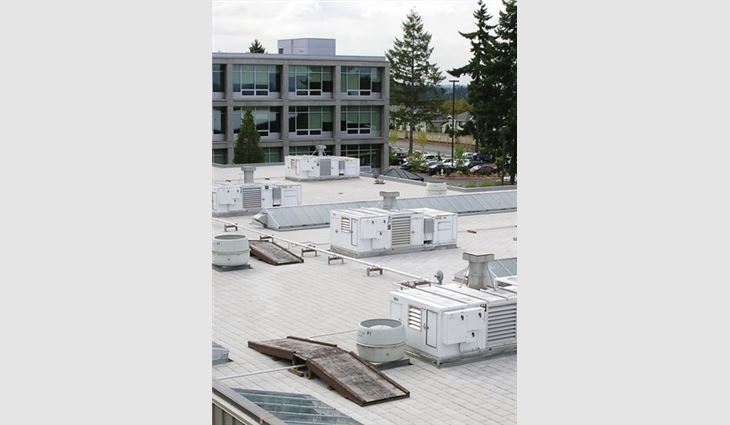 Photo courtesy of Wayne's Roofing Inc., Sumner, Wash.
Photo courtesy of Wayne's Roofing Inc., Sumner, Wash.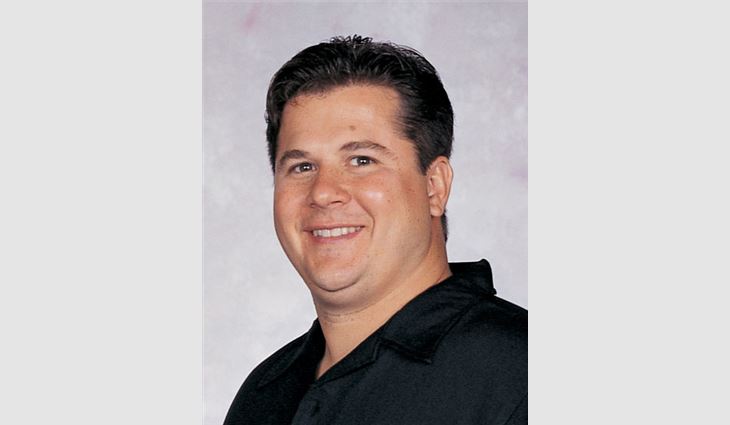 Photo courtesy of Wayne's Roofing Inc., Sumner, Wash.
Photo courtesy of Wayne's Roofing Inc., Sumner, Wash. 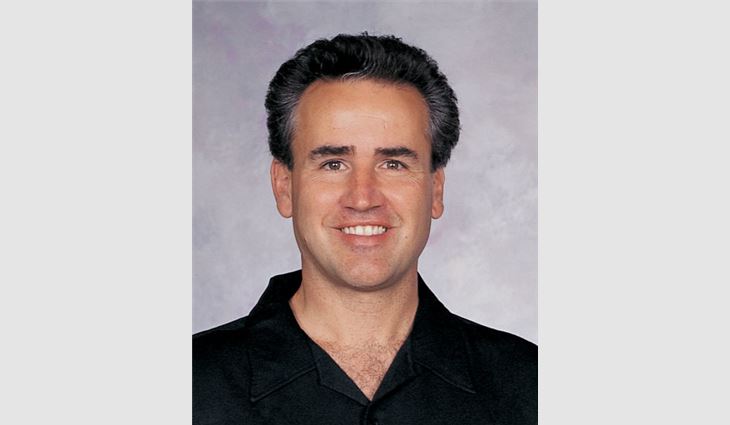 Photo courtesy of Wayne's Roofing Inc., Sumner, Wash.
Photo courtesy of Wayne's Roofing Inc., Sumner, Wash. Photo courtesy of Wayne's Roofing Inc., Sumner, Wash.
Photo courtesy of Wayne's Roofing Inc., Sumner, Wash.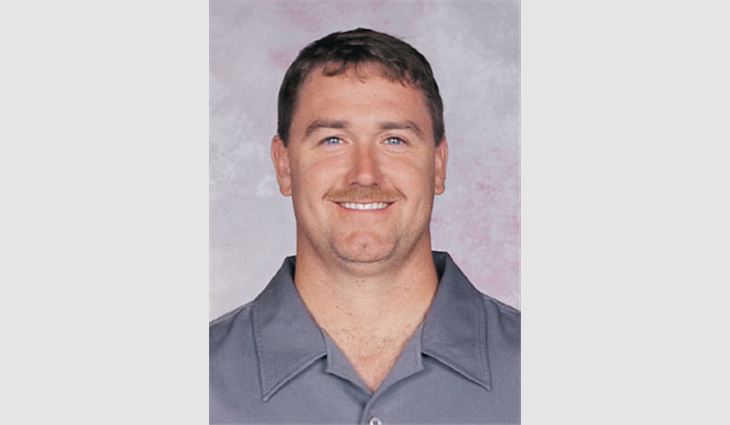 Photo courtesy of Wayne's Roofing Inc., Sumner, Wash.
Photo courtesy of Wayne's Roofing Inc., Sumner, Wash. Photo courtesy of Wayne's Roofing Inc., Sumner, Wash.
Photo courtesy of Wayne's Roofing Inc., Sumner, Wash.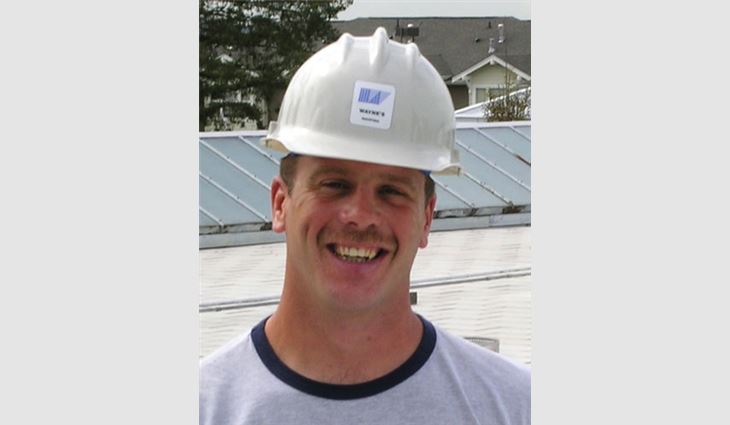 Photo courtesy of Wayne's Roofing Inc., Sumner, Wash.
Photo courtesy of Wayne's Roofing Inc., Sumner, Wash.Professional Roofing covers interesting projects through features highlighting unusual or challenging jobs. But projects that may seem run-of-the-mill with respect to size and roof system installation sometimes can prove as challenging as the most complex roof system installation.
Professional Roofing asked employees of NRCA member Wayne's Roofing Inc., Sumner, Wash., to describe how they approached a seemingly typical job. What follows is how the job progressed from each of their perspectives.
Bidding the job
Rod Wetherbee, Wayne's Roofing's vice president, oversaw the bidding of the job.
"This was a publicly bid job that was advertised in the local newspaper. We had bid repair work for the client during the past two years but had been unsuccessful. The project would be our first with this particular client.
"The specification called for a modified bitumen roof system manufactured by either Siplast/Icopal, Irving, Texas, or Soprema, Wadsworth, Ohio. These manufacturers are well-respected in our marketplace for their abilities to maintain high-quality applicators, and therefore, the competition was good. And when I say good, I mean these were contractors we compete against on a regular basis and who have similar markup structures as we do.
"It took about six days to prepare the bid. Preparation included a prebid walkthrough; preparing the estimate to ensure we had insurance bid coverage for the various subcontract phases (sheet metal, lightweight concrete, electrical, mechanical, etc.); and gathering the necessary paperwork for a responsive bid (bid bond, manufacturer's certification letter and warranties). We knew the economy was experiencing difficulties with the stock market crash, Sept. 11 catastrophe and possible threat of war, so we chose to aggressively look at this particular project. The benefit of this job is that it would keep one of our crews busy through winter and into spring; the other benefit of this job was there was enough ballast to remove and pavers to install that 50 percent of the job could be done in wet weather conditions.
"For this particular project, because it was publicly bid, the lowest responsible bidder would be awarded the project. The specification was determined before the bid by the owner, architect and roof consultant. The manufacturer we chose to use for bidding purposes was based on the price of the specified material.
"The roof assembly primarily consisted of a concrete deck, vapor barrier mopped solid to the deck, built-up roof membrane, insulation and gravel. The biggest challenge was determining at what rate we could remove these products in an occupied school environment.
"We were awarded the project for $770,000. There were six responsive bidders. The next lowest bid was about $882,000. The highest bid was about $1 million. The price difference definitely was scary! We were 13 percent lower than the next bidder and 28 percent lower than the high bidder. Usually, we are within 2 percent to 3 percent of the next bidder. I immediately reviewed my bid to determine whether an error was made. We felt comfortable with the bid and notified the owner we planned to accept it.
"The project was awarded immediately, and the submittal process started about two to three weeks after actual bid date. Work began immediately thereafter."
Materials
Don Guthrie is president of Wayne's Roofing. He oversaw the project and performed material ordering.
"The materials used on this project were purchased through several distributors and manufacturers. As a result of advance ordering, good communication and excellent job management by our key project personnel, materials were supplied to the project on time and in the best possible sequence to facilitate the orderly process of the work while not consuming limited on-site staging areas.
"The materials selected for this project were based on the preferences of our client, Bellevue Community College, Bellevue, Wash. The college selected Siplast's 20/30FR SBS-modified bitumen roof system based on guidance provided by the roof consultant, architect and manufacturer's representative.
"Potential challenges that could have affected this project were wet winter weather and possible disruptions of an active college campus with more than 30,000 students and faculty. With this in mind, our seasoned management staff reviewed these potential challenges in advance with the facility representatives. Appropriate procedures were identified, initiated and monitored to significantly mitigate disruptions or quality concerns that otherwise may have occurred."
Project management
Joe DiCarlo was the project manager, and Dan Johnson is Wayne's Roofing's operations manager.
DiCarlo: "To begin planning, we reviewed the project's specifications and plans with the project estimator and verified square footage per roof area for the roof system being specified. We also compared the project's specifications and plans with the estimator's take-off. We then reviewed and verified subcontractor proposals were complete and discussed current projects under contract and schedule commitments, as well as who was experienced to perform the scope of work being specified. The project did not require any unusual safety training, but job-specific weekly safety meetings were maintained. We selected a crew that had past experience with the roof system and a scope of work similar to what was specified."
Johnson: "After reviewing the plans and specifications with DiCarlo and the foreman, we visited the project site to develop a plan of action. After reviewing the site, a preconstruction meeting was scheduled with representatives from the college, consulting firm and manufacturer. The schedule, roof system, and special requirements for setup and safety were discussed, and a plan of action was made.
"We then chose a qualified crew to begin the project. The crew selected was headed by foreman Chuck Richmond. His crew has installed thousands of squares of torch-applied SBS-modified bitumen on many project sites, which made the crew the perfect selection. Our crew began setting up the site by erecting ground barricades to keep students out of construction areas and rooftop safety for roof demolition and installation.
"Performing this project while school was in session was an added obstacle. Noise, storing materials on-site, asphalt fumes, pedestrian traffic and limited access to the buildings were challenges but were made easier by the guidance of school officials. Weekly job-site safety meetings were held throughout the project's duration. The limited access to the work areas was overcome by the use of an 8,000-pound (3629-kg) forklift operated by one of our certified operators."
DiCarlo: "Once the removal of the existing roof system began and existing conditions were determined, several change orders became necessary. The facility manager, state representative, architect, manufacturer's representative, roof consultant, foreman and I collectively determined best resolutions to concerns that would maintain the specified manufacturer's warranty and enhance the roof system's longevity while staying within budget. Proposals were provided that varied from modifying rooftop ladders to using low-fume asphalt to requiring the emergency replacement of an additional 21,100-square-foot (1960-m²) area over the roof of an occupied classroom building. Before acceptance of all change orders, cost proposals and related schedule issues were reviewed and accepted. Notice to proceed with change orders was given Sept. 25, 2002, with a 75-day completion time. Because of inclement weather, sensitivity of the building and acceptance of various change orders, the project completion date was extended an additional 75 days.
"A portion of the work, following removal of the existing roof system, required a new tapered insulating lightweight concrete application over the existing structural concrete deck. This work had to be scheduled before winter set in and coordinated with the selected subcontractor's schedule. In addition, the insulating concrete equipment and roofing materials had to be staged and applied without interrupting daily classroom activity and the college's theater performances."
Johnson: "The ability for us to move our workers to perform work on other buildings to remove ballast or install pavers provided us with little down time during inclement weather, which seemed far too common. School activities that could not be interrupted by construction were overcome by also performing work on other parts of the project that would not interfere with school activities. Our crew topped out at about 15 workers to 20 workers every day performing many different tasks and spread out over several buildings. Excellent job-site management and dedicated employees made this job a success."
DiCarlo: "The facility manager was an involved owner representative. Open lines of communication developed early between the facility manager and project foreman. The facility manager's expectations were voiced and then put into practice, which enabled our company to better satisfy the needs and requirements for present and future concerns."
Johnson: "Other than the obvious challenges weather brings, the unpleasant smell of asphalt was the culprit that evacuated students from buildings once during the project's duration. Lack of on-site storage also posed a problem. Material usage was closely monitored and deliveries were scheduled accordingly."
DiCarlo: "Meetings were held every Wednesday with the state representative, college representative, architect, consultant, manufacturer representative and us. Topics of discussion were progress schedule, reviewing the week ahead, unresolved issues, outstanding cost proposals, scheduling issues and conditions that could be modified from the specifications that would better serve the facility's best interest.
"When requested, theater performances and daily classroom activity schedules were provided during the weekly meetings so a mutual understanding and expectations of what would be tolerated with respect to noise level, asphalt fumes and ground storage/staging would not affect the facility and/or our scheduled work day. Overhead crane and street use required Saturday activity to minimize any inconvenience to the students and facility operations."
Johnson: "Limiting delivery times to not coincide with the start of school and an occasional performance in the theater that made us move work to another building for a day were the only special scheduling needs encountered. This always was discussed in advance with school officials and conveyed to our on-site people to avoid any disruptions to school operations."
The work
Chuck Richmond was the crew foreman.
"My workers have a wide range of experience and ethnic backgrounds. My more seasoned roof technicians help apprentices be safe and more efficient at their daily jobs. This project needed special attention to safety because of the large presence of students.
"My crew members changed daily according to the work. On demolition days, extra help was needed; on roofing days, the number of workers decreased.
"When I had a large number of Spanish-speaking crew members who usually aren't on my crew, my regular Spanish-speaking crew members helped communicate daily goals and expectations.
"An inverted roof membrane assembly made demolition less effected by rain than most roofing jobs. Demolition on rainy days gave us the ability to work every day through the winter.
"Some ballast removal had to be done around the college's schedule. Students' presence, college functions and my need for a crane to reach inaccessible roof areas made us work on weekends and schedule activity during school breaks and holidays."
All in a day's work
It's easy to become accustomed to daily issues and challenges related to different projects—most people just take them in stride. But when you collect all the challenges related to a seemingly typical job, it's difficult not to notice how many things can affect a roofing project—regardless of how simple the installation process seems. Wayne's Roofing provides just one example of the challenges roofing contractors face daily.
Ambika Puniani is editor of Professional Roofing and NRCA's director of communications.
Project name: Bellevue Community College, Bellevue, Wash.
Project duration: 150 days
Original roof system type: Inverted roof membrane assembly
Replacement roof system: SBS-modified bitumen
Scope of work:
COMMENTS
Be the first to comment. Please log in to leave a comment.